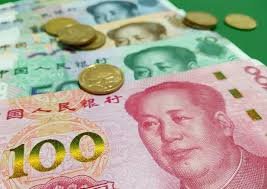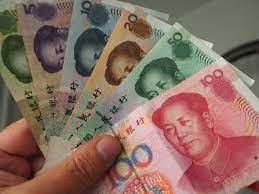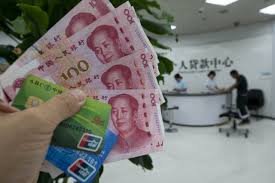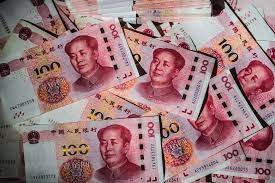Introduction Of Yuan:

The yuan, China’s official currency, holds a significant position in the global financial ecosystem. Its influence continues to grow as China expands its economic power worldwide. Whether you’re an investor, a student of global economics, or simply curious about foreign currencies, understanding the China’s yuan is vital. In this article, we’ll explore the yuan’s history, its role in the global economy, how it works, and its future prospects.
What is the Yuan?
The China’s yuan (元) is the basic unit of the Renminbi (RMB), which is the official currency of the People’s Republic of China. Often referred to interchangeably, the terms yuan and Renminbi have subtle differences. While the Renminbi represents the currency system, the yuan is the actual unit of currency used in transactions. For example, one might say, “This costs 50 yuan.”
The China’s yuan is abbreviated as CNY (Chinese Yuan) in international markets, while CNH refers to the China’s yuan traded offshore, typically in Hong Kong and other international financial centers. The currency is further symbolized as ¥, similar to the Japanese yen.
A Brief History of the Yuan
1. Origins in Ancient China
The origins of the yuan can be traced back to ancient China, a civilization known for pioneering currency innovations. During the Tang and Song Dynasties, China developed the earliest forms of paper money, a precursor to the modern yuan.
2. The Birth of Modern Currency (1948)
The Renminbi was introduced in 1948 by the People’s Bank of China (PBOC) to stabilize the country’s economy during the Chinese Civil War. Since then, the yuan has undergone significant transformations, reflecting China’s rapid economic growth and policy adjustments.
3. Reform and Opening Up (1978)
China’s economic reforms initiated by Deng Xiaoping in 1978 marked a turning point. The yuan began its journey towards integration into the global financial system. By the early 2000s, China’s increasing trade surplus and foreign exchange reserves made the yuan an economic force to reckon with.
How Does the Yuan Work?
1. Managed Float System
The yuan operates under a managed float system. The People’s Bank of China sets a daily midpoint rate for the yuan against the US dollar, allowing it to trade within a certain range. This approach balances market forces while maintaining governmental control over exchange rates.

,Yuan
2. Onshore (CNY) vs. Offshore (CNH)
- CNY: Refers to the yuan traded within mainland China under strict government regulations.
- CNH: Refers to the yuan traded outside of China, particularly in Hong Kong. The CNH rate is determined more by market dynamics and less by the Chinese government.
3. International Trade and Settlements
China actively promotes the yuan’s use in international trade. Countries engaging in substantial trade with China increasingly settle transactions in yuan rather than US dollars. This shift supports China’s ambitions to internationalize its currency.
The Yuan in the Global Economy
1. Inclusion in the IMF’s SDR Basket
In 2016, the International Monetary Fund (IMF) included the yuan in its Special Drawing Rights (SDR) basket, alongside the US dollar, euro, Japanese yen, and British pound. This inclusion recognized the yuan as a global reserve currency and marked a milestone in its internationalization.
2. Belt and Road Initiative (BRI)
China’s ambitious Belt and Road Initiative has also propelled the yuan’s prominence. Many infrastructure projects financed by China encourage the use of the yuan for payments, further solidifying its global standing.
3. Reserve Currency Status
Central banks worldwide are increasingly holding yuan as part of their foreign exchange reserves. According to the IMF, the yuan accounted for approximately 2.9% of global reserves as of 2024, a small yet growing share compared to the US dollar.
Advantages of Using the Yuan in Global Trade
- Reduced Exchange Rate Risks: Countries trading in yuan avoid the costs and risks associated with converting to and from other currencies, particularly the US dollar.
- Strengthened Bilateral Relations: Settling trade in yuan fosters closer economic ties with China.
- Lower Transaction Costs: Direct yuan settlements eliminate the need for intermediaries, reducing transaction fees.
Challenges Facing the Yuan

,Yuan
1. Capital Controls
China’s strict capital controls limit the free flow of yuan in and out of the country. While these measures protect the domestic economy, they hinder the yuan’s full convertibility on global markets.
2. Geopolitical Tensions
Trade disputes and geopolitical issues, particularly with the United States, often affect the yuan’s stability and adoption as a global currency.
3. Trust and Transparency
For the yuan to achieve widespread adoption, international stakeholders demand greater transparency in China’s monetary policies. Skepticism about government intervention in financial markets remains a barrier.
The Yuan’s Role in Emerging Markets
Emerging economies in Asia, Africa, and Latin America increasingly use the yuan for trade and investment. Here are some examples:
- Africa: Many African nations, part of China’s Belt and Road Initiative, settle infrastructure payments in yuan.
- Southeast Asia: ASEAN countries often trade with China in yuan due to geographical and economic ties.
- Latin America: Countries like Brazil have begun exploring yuan-based trade agreements to reduce reliance on the US dollar.
Digital Yuan: A Game Changer
China has taken a pioneering step in digital currencies by developing the Digital Yuan or e-CNY. This central bank digital currency (CBDC) is designed to modernize payments and challenge existing systems like Bitcoin and stablecoins.

,Yuan
1. Objectives of the Digital Yuan
- Modernize Payment Systems: The digital yuan aims to streamline transactions and reduce reliance on cash.
- Internationalization: As an electronic currency, it facilitates cross-border payments and strengthens the yuan’s global role.
- Data Control: Unlike decentralized cryptocurrencies, the digital yuan gives the Chinese government greater control over financial data.
2. Pilot Programs and Adoption
The digital yuan is already being tested in cities across China and used for small-scale international transactions. Countries like Russia and the UAE have expressed interest in exploring its potential.
The Yuan vs. the US Dollar
The yuan’s rise challenges the dominance of the US dollar in global trade and finance. While the dollar remains the world’s primary reserve currency, the yuan offers an alternative for countries seeking diversification.
1. Benefits for China
- Economic Sovereignty: Reducing reliance on the dollar minimizes China’s vulnerability to US sanctions.
- Increased Influence: A strong yuan boosts China’s influence in global economic governance.
2. The Road Ahead
Despite its progress, the yuan has a long way to go before it can rival the dollar. Enhancing liquidity, increasing global acceptance, and achieving full convertibility are critical steps.
How to Invest in the Yuan
For investors looking to capitalize on the yuan’s growth, there are several options:
- Currency Trading: Buy and sell yuan through forex markets. Investors can trade CNY or CNH depending on their market access.
- Yuan-Denominated Bonds: Known as “dim sum bonds,” these are issued in yuan and traded outside China.
- Chinese Stocks and ETFs: Investing in Chinese equities or exchange-traded funds (ETFs) provides indirect exposure to the yuan.

,Yuan
Future Prospects of the Yuan
The yuan’s journey is far from over. With China’s ongoing economic reforms and technological advancements like the digital yuan, its role in the global financial system will likely expand. However, challenges such as capital controls, geopolitical tensions, and market skepticism must be addressed.
In a multipolar world where economic power is diversifying, the yuan has the potential to be a significant player. Its success will depend on balancing domestic priorities with international demands, building trust, and maintaining stability in an ever-evolving global economy.
Conclusion
The yuan’s rise reflects China’s ambition to reshape the global economic order. As it transitions from a regional currency to a global contender, understanding its history, mechanics, and future trajectory is essential for anyone navigating the complexities of international finance. Whether through traditional forms or the innovative digital yuan, the Chinese currency is poised to play an increasingly prominent role in shaping the future of global trade and investment.
